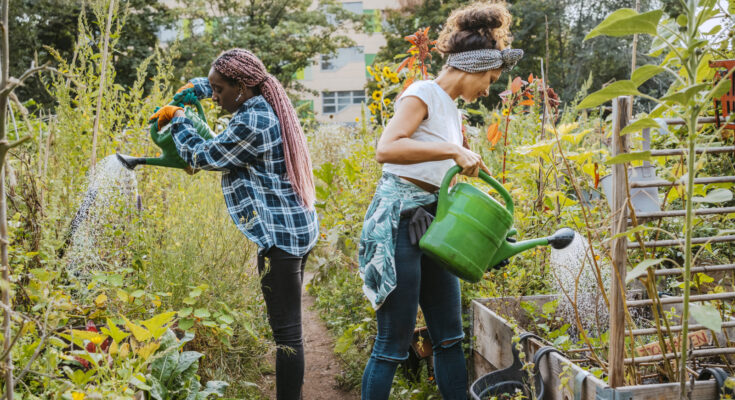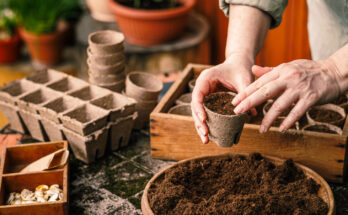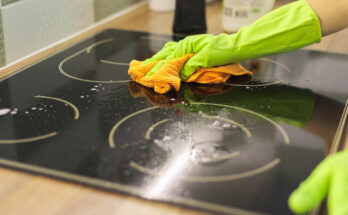Essential Tips For Watering Your Vegetable Garden Efficiently
We may receive a commission on purchases made from links.
Have you been inspired by other people’s veggie garden ideas and are ready to get your hands dirty to reap the fruits — or veggies — of your labor? Us, too! Creating a vegetable garden has so many benefits that go beyond putting food on the table that it’s easy to see why more people are picking up the pitchfork and thumbing through seed catalogs. While there aren’t many rules around what you can grow, as long as it works in your USDA Hardiness Zone, or which garden design to use, there are a few methods you’ll need to stick to if you want a bountiful harvest. One category of those methods is watering — and it’s more complicated than you might think.
That’s why we’ve rounded up a few genius tips for watering that gardeners of any level can use to nail their routine. We’ll cover why the tips works and give some hints for ensuring you’re doing it right, which veggies love it the most, and even a few signs that you might need to switch things up a bit. So start decanting your water barrel and let’s get started.
Prioritize watering seedlings and very young plants
We get it, starting a new garden from scratch is exhausting — all you want to do is relax and let the seedlings do their thing. But this is the time that’s most crucial for your fledgling plants; they’ve got to spend lots of energy germinating and if they don’t have enough water, it will result in stunted growth and reduced yields. The first few weeks are when your veggies need you to stay on top of your water routine the most. That could mean watering every day, especially if you live in a hot, dry climate so, hunker down because we’ve still got more work to do.
But look, obsessive watering doesn’t have to last forever, so don’t worry that you’ve gotten yourself into more than you can handle. The rule of thumb we like to stick to is to water enough so that the top 3 to 4 inches of soil are moist. On average, you should expect to keep this routine up for around a month or until your seedlings reach 4 to 5 inches in height. After that, you can back off a bit to approximately 1 inch of water per week during the active growing season.
Know what type of soil you have to ensure you’re watering the right amount
Not all soil is created equal, and the type of soil you grow your vegetables in will matter for both your crops and your water routine. As too little water can stunt growth and yields, and too much water can block the roots from accessing oxygen, striking the right balance is important — and that balance will depend on your soil type. Most often you’ll see soil types categorized by their texture and the size of their particles: sand, silt, clay, loamy, chalk, or a combination of at least two. Sandy is the loosest and will require more water since it drains the best. Silty soils drain well, but can compact easily, so hold water a little better than sand. Clay soils are dense and require less watering, and can become waterlogged if you’re not careful. Loamy is the GOAT of soil types because its a combination of sand, silt, clay, and chalk, so it drains well, but still maintains adequate moisture. Chalk soils are free-draining thanks to the chunks of limestone in their makeup, so they will need lots of water (they’re also alkaline and can’t grow acid-loving plants, FYI).
How do you know which type of soil you have? The easiest way is to grab a slightly-moist clump in your hand. First, the color of your soil tells you a lot. If it’s dark, then that means it has organic matter, so it can hold more water and needs less of your time; lighter soils have more minerals, so they’re more likely chalk or sand, which means they’re well-draining and need more watering. Next, toss your clump into a mason jar with a lid then fill it with water and shake for a few minutes. Let the jar sit until the soil has settled and the water is clear. Look at the layers of your soil — organic matter will be on top, clay will be under that, silt under that, and the largest, heaviest particles on the bottom. Based on the thickness of each layer you can take an educated guess on what your soil texture is and strategize your water routine accordingly. The NOAA has a helpful table that breaks down loamy soil types based on percentages if you want help.
Plan to water more frequently if you’re using containers
Container gardening is great for those who only have a small balcony or need to chase the sun to give their plants the light they need. The biggest problem with container gardening, though, is that your vegetables won’t be supported by a yard’s worth of soil moisture — it can only draw from the soil that’s in the planter. They also have a harder time with excess moisture, particularly if they don’t have enough drainage holes, which can lead to root rot or crop failure.
However, that doesn’t mean you should give up on having a container vegetable garden; it just means you’ll need to be a little thoughtful with your water routine. First, make sure you’re picking vegetables that can easily grow in containers. Also, use a potting mix that has additives in it that help retain moisture and improve drainage. Perlite is perfect for both and is often already in pre-made soil blends — it’s those white-looking beads. You can always add more, though, like with the TOYPOPOR Perlite for Plants. Vermiculite is another option that does double-duty and can hold up to four times its weight of water.
Adjust your water routine based on the veggies you’re growing
If you’ve ever owned a succulent and a pothos at the same time then you know their water needs are completely different; the same goes for veggies. Cool-season vegetables like carrots and broccoli need less water, while warm-season vegetables, such as tomatoes and peppers, will need more water. The lifecycle of your crops also matters, as transplants, flowering crops, and seedlings will need more frequent watering, while slower-growing ones may need less.
The easiest way to get this right is to group your vegetables by water requirements based on harvest time — just make sure you’re also considering the amount of light each crop needs, too. Not only will this cut down your need to keep this all in your head, but it will also lead to healthier, more productive plants. For example, tomatoes and peppers have about the same amount of time before harvest, around 70 to 90 days, and like more water. Meanwhile, sweet potatoes can take up to 150 days, so would do better in an area that gets watered less.
Check the soil’s moisture level before watering
If you want the most straightforward method for seeing if your vegetables need water, check the soil’s moisture before heading for the garden hose. This is particularly important if your soil’s texture is dense or heavy in clay, as it can make it difficult for your plants to get rid of excess moisture. As we’ve mentioned, too little water and your veggies won’t grow properly; too much water and you face issues of waterlogging and root rot.
There are two ways to check your soil’s moisture easily. The first is to buy a moisture meter; XLUX’s Soil Moisture Meter has a long probe that will let you dig deep to detect water. The other option is to DIY it with a trowel. Dig a small hole that’s 2 to 4 inches down and feel the soil with your fingers. If it’s moist, you’re all set, but if it feels dry or crumbly, it’s time to give your crops a drink. Do this before you water and around 30 minutes post-watering. If the soil still feels dry, water it again. If it feels like it’s soaking wet, you’ve gone overboard and will need to let the soil dry out before your next watering.
Don’t wait for your plants to show signs of water stress before watering
Some gardeners prefer to go with the flow and wait for their vegetables to show signs that they’re thirsty. Please don’t do this. Like cats, plants can be weird with showing signs of stress, and it may already be past the point of no return by the time you notice. Playing fast and loose with a “wait and see” method can lead to a host of problems, like making your vegetables more prone to disease, more likely to be injured, and a reduction in crop yields.
In a way, it makes sense to wait for signs of water stress; it’s easier to water dry crops than it is to deal with root rot. But, think of it like how our bodies experience hypothermia; wilted or curled leaves mean that the plant is tapped out of resources and has begun to pull back, so giving it a quick douse could be too little for it to recover, or too late for it to try. Instead, use automation tools (more on that later) if you need help determining moisture levels or dip your finger into the soil and check it yourself. Your bounty will be much better when you pay attention to the soil instead of the foliage.
Measure exactly how much water you’re providing
You might think a once-over pass with the sprinkler is enough, but vegetable gardens require more watering precision than that. On average, the healthiest veggie gardens receive about an inch of water a week. That might not seem like much, until you think about how wide your garden is. One square foot of garden needs 0.62 gallons to reach an inch’s worth of water.
The easiest way to ensure you’re hitting that 1 inch mark is by measuring it. Don’t worry, there are lots of tools that can handle this for you. The low-tech method starts by calculating the area of your garden and getting the square footage, then multiplying that by 0.62. So, if your garden is 10 feet by 10 feet, you’ve got 100 square feet of space and will need 62 gallons. Next, get a watering can or bucket of which you know the volume and fill it accordingly. The staple 5 gallon bucket from a big box store will require over 12 trips to the hose.
The other less math-y option is to just install a water meter on your garden hose, like Diivoo’s Water Flow Meter. Hose meters work by attaching at the spigot or the sprayer, and counting the water usage for you. It’s much easier to handle and some can even be added to hoses that use water barrels instead of municipal water.
Add mulch to reduce your watering frequency
Soil is good for locking in moisture, but that doesn’t mean it’s perfect. Wind erosion and evaporation can each take away the precious water your vegetables need to thrive. So, add a thin layer of mulch on top of your soil. Not only will it help conserve water, but it can help reduce your watering chores thanks to its water retention capabilities. Plus, you can get multiple types of mulch for cheap or even free, depending on your municipality. Many towns offer bulk mulch for free that’s leftover from landscaping projects or as a byproduct of tree cuttings.
If you need a lot and your budget is tight, ChipDrop is an awesome resource. Arborists will drop their wood chips off at your house for a small fee or even for free. But, here’s the catch: ChipDrop doesn’t let you specify how much you need, so you could get anything from 4 cubic yards to 20 cubic yards; it’s up to the arborist and their inventory and you’re required to take the whole load. Some go in on an order with their neighbors to help mitigate the amount, while others only use it for substantially-sized gardens. If that’s not worth the gamble, you can also keep an eye out on your local hardware or nursery for mulch deals that typically fall around the start of growing season.
Water your vegetables in the morning
The time of day you water matters, so shoot for the morning. Heat causes more evaporation, so watering earlier in the day allows your vegetables to get the full extent of the water they need. This is especially important for warm season veggies. While you can water in the evening, you run the risk of the soil and foliage staying too wet, leading to crop or root rot and an increased likelihood disease overtaking your crops. Morning watering allows some water to evaporate, but not too much to compromise their much-needed drink.
If hand watering in the morning is a no-go, consider using an automated sprinkler to take the workload off your chore list. You can go low-tech and just get a sprinkler timer like the RAINPOINT Programmable Water Timer, or go super high tech and use a RAINPOINT Wi-Fi Water Timer that lets you monitor it on your phone. We’d recommend using one that lets you monitor or control the amount of water so that you can hit the 1-inch’s worth goal your vegetable garden needs.
Water deeply and less frequently
What’s better, watering your veggies a little here and there or doing a deep saturation once in a while? If you read the title of this section, then you already know it’s the latter — but, why? It has to do with your veggie’s root systems. Watering deeply enough teaches your crops to push their roots down in search of water, rather than staying more shallow and seeking water closer to the soil’s surface. Not only do deeper roots help anchor plants in soil, but they also encourage crops to be more drought-resistant so they can withstand the summer heat and still produce lots of delicious veggies.
So, how often should you give the soil a good soaking? It depends on your soil texture, amount of rainfall, and types of vegetables. But a general rule of thumb is every five days for light-textured soils, once a week for middle-of-the-road soils, and every 10 days for clay-heavy soils.
Water the soil, not the foliage
If there’s one thing we want to teach you it’s to put water where it counts. We know, the easiest method is just to do a sweeping spray across your crops with the hose, but taking the time to ensure water hits the soil and not the leaves will do more to help your vegetables than you think. First, and arguably most important, the parts that need the water the most — the roots — end up being neglected thanks to all of that delicious, beautiful water just evaporating off the leaves. And whatever doesn’t evaporate becomes problematic, because when foliage is wet, it’s like a dinner bell for pathogens — and pathogens lead to disease.
We know it’s difficult to get to the soil with foliage-dense crops like bush beans or lettuces, so do your best or use irrigation tools that ensure water gets delivered to the places it needs to go (but more on that in a second). Sprinklers can help since they’ll give a prolonged douse of water, just make sure it’s running in the morning so that whatever’s left on the leaves has time to evaporate.
Try using drip irrigation
Drip, or trickle, irrigation is a gardener’s best friend. Remember we discussed how focusing water on the soil, rather than foliage, is important? Well, this relates. Essentially, they’re hoses with lots of tiny holes and will slowly release water directly onto the soil, removing the risk of wet leaves and reducing the risk of fungal diseases that germinate through excess moisture on your precious vegetables. Plus, they save you time and effort, as you hook them up to water barrels and pumps that automate the process for you.
However, there are a few downsides. First, they’re kind of costly. This Solar Automatic Drip Irrigation Kit System by JIYANG is around $45, as of this writing, and is good for anywhere from 20 to 30 containers, depending on their sizes and distance. Also, they have a bit of a learning curve to install, because you’ll need to calculate how much tubing you’ll need. But once the system is set up, you — and your veggies — will be more than glad you made the effort.
Or, automate your water routine with milk jugs instead
If you want a super low-tech method to help reduce your vegetable garden watering chores, try this DIY method that repurposes empty milk jugs into a type of drip irrigation system. Collect and clean gallon milk jugs and drill a few holes into their bases. Then bury them next to water-hungry plants so that just the top of the jug is sticking out. Fill the jug with water and let it do its thing.
The jugs act like slow-releasing watering cans that ensure deep-rooted plants get the moisture they need right where they need it (in the soil, not on the greenery, remember?) You can even add a scoop of water-soluble fertilizer to each jug when your plants are in their fruiting stages to promote bigger harvests. This is a low cost approach to drip irrigation that reduces the risk of fungal diseases from overhead watering.



